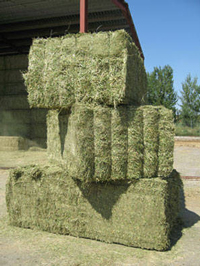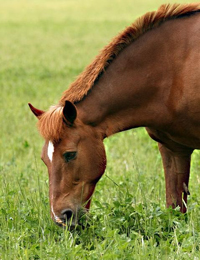June 2017
Forages: Myths or Facts?
Holistic Horsekeeping
How to have a healthy happy horse.
Volume 22, Number 6
=*=*=*=*=*=*=*=*=*=*=*=*=*=*=*=*
In This Issue:
1. Forages: Myths or Facts?
2. Holistic Learning Opportunities
=*=*=*=*=*=*=*=*=*=*=*=*=*=*=*=*
1. Forages: Myths or Facts?
By special guest contributor Nerida Richards, PhD*
This article was written by Dr. Nerida Richards B.Rur Sc. PhD (RAnNutr), FeedXL Resident Nutritionist, for the Spring 2017 newsletter put out by Equi-Analytical Laboratories, which is the resource I prefer and recommend for hay testing. My thanks to both of them for allowing us to re-print it and share it with you. You can see more about Dr. Richards in her bio below. – Madalyn
There are several widely-touted myths surrounding the carbohydrate composition and nutritional value of common forages. Let’s take a look at a few of these below:
Myth: Alfalfa hay is high in starch and sugars.
Fact: Alfalfa hay is usually less than 12% starch and sugars and its starch and sugar content varies less than grass.
Alfalfa hay usually contains less than 12% starch and sugars. The Equi-Analytical Common Feed Profiles database gives an average value of 1.7% starch and 9.2% WSC on a dry matter basis for legume hay.
Alfalfa also seems to vary less in its potential starch and sugar content than grass hay. Equi-Analytical gives a range of up to 2.6% starch and 11.1% WSC for legume hay. Compared to grass hay which has a range of up to 3.2% starch and 16.1% WSC, the potential variation in alfalfa is much lower.
This means that where a low sugar, low starch diet is required, alfalfa can certainly lend a useful hand in forming part of the forage base of the diet. Alfalfa must be used in moderation as part of a balanced diet as protein, digestible energy, calcium and phosphorus levels must also be taken into consideration. And to really be sure of your alfalfa hay’s starch and sugar content-have it tested!
Myth: Good quality forage can provide all the nutrients your horse needs.
Fact: Good quality forage is usually unable to meet a horse’s requirement for copper and zinc and may not meet requirements for selenium and iodine.
It is often said that feeding a good quality hay is all your horse should need to stay healthy. Unfortunately this is not the case. While good quality forages are often more than capable of providing enough calories and protein, more than 90% of the several hundred forages I have had analysed by Equi-Analytical were not capable of meeting a horses minimum (NRC) copper and zinc requirements.
The NRC gives a minimum requirement of 10 mg/kg of feed intake for copper and 40 mg/kg of feed intake for zinc. In the Equi-Analytical database, grass hay has an average of 7.8 mg/kg of copper and 28.1 mg/kg of zinc (on a 90% dry matter/as fed basis), both below minimum requirements for idle horses.
If left unsupplemented on forage only diets, over time, copper and zinc deficiency will manifest as poor quality hooves, dull coats, declining joint health and weak immune systems amongst a myriad of other potential issues.
While not commonly analysed, we know from historic records that certain geographical areas produce forages that are also too low in selenium and iodine to meet minimum requirements.
Having your pasture and/or hay tested will show you very quickly which nutrients are sufficient, over or under supplied when it comes to meeting your horse’s daily requirements. Once you have had your forage tested, you can work with your equine nutritionist or use a service like FeedXL.com to figure out what you need to add to your forage to meet your horse’s full nutrient requirements for long term health.
Myth: Grass hay and pasture nearly always contain more calcium than phosphorus.
Fact: Grasses often have more phosphorus than calcium.
Read any text book or look up any database for mineral levels in grass hay or pasture and you will see that grass forages contain more calcium than phosphorus – which means diets based on grass hay or pasture should have a balanced calcium to phosphorus ratio … right? Well, maybe not!
Around 50% of the pastures I have tested in the last 7 years have contained more phosphorus than calcium, with calcium to phosphorus ratios tested as low as 0.2:1 and commonly tested around 0.5:1 (the ideal ratio is around 2:1). It is well known that diets containing more phosphorus than calcium can lead to a phosphorus induced calcium deficiency. So being well on top of your pasture or grassy hay’s calcium to phosphorus ratio is important if you want to avoid serious issues with calcium deficiency and the resulting secondary nutritional hyperparathyroidism (or bighead disease). The only way to know what your grass forage’s calcium and phosphorus content is to test it!
Myth: Pasture is highest in sugar in the early hours of the morning.
Fact: Pasture is lowest in sugars in the early hours of the morning.
Plants use the process of ‘photosynthesis’ to make carbohydrates from carbon dioxide, water and sunlight. These carbohydrates can be in the form of starch, fructan and simple sugars. The plant then uses these carbohydrates as a source of energy to grow, so effectively, they make their own food (clever huh!).
A very basic 24 hour timeframe for a plant looks like this.
1. Sunrise – photosynthesis starts and the plant begins to make carbohydrates;
2. Daytime – photosynthesis continues, the plant uses the carbohydrates to grow when temperature, moisture and nutrient conditions are right, plus they make some extra for the night-time;
3. Night-time – the plant uses its reserve of carbohydrates to survive and to continue to grow during the night when it doesn’t have any sunlight to make more carbohydrates, so that by morning carbohydrate levels are lowest.
When it is too cold to grow, or if the plant is nutrient stressed the plant will still photosynthesise during the day and produce carbohydrates, but it doesn’t burn up many sugars or starch in the growth process… so they accumulate. This means that when plants are stressed they can be absolutely loaded with starch and sugars. This also means that while stressed plants will still be lowest in starch and sugars in the very early hours of the morning, they can still be very high (>12%) in starch and sugars at this time of day. So don’t assume the early morning is safe for grazing just because it is the early morning. There are many other factors at play.
This may be starting to sound boring, but again, you need to test your pasture to know what it is doing in certain seasons during certain times of the day. While it won’t tell you what the exact level of starch and sugar will be in your pasture tomorrow morning for example, it will at least give you more idea than a complete guess!
*Dr. Nerida Richards is the Managing Director and Principal Consultant of Equilize Horse Nutrition Pty Ltd, Tamworth, NSW, Australia, a company that specializes in providing independent, professional advice in all areas of equine nutrition. Within her role, Nerida provides high-level technical support to numerous national and international feed and supplement companies, as well as on the ground advice and technical support to breeding and training establishments. Nerida designed, developed and commercialised FeedXL, http://www.feedxl.com/, a ration evaluation program used by horse owners and industry professionals alike.
2. Holistic Learning Opportunities
At Holistic Horsekeeping we have a way to learn about caring for your horse holistically for everyone and any schedule. From courses to books to ebooks to audios, everyone can learn a variety of topics that will give a deeper understanding of horses and give you a happier, healthier horse.
This self-paced online course is open to anyone interested in learning more about the Horse Temperament Types. It was created to share information about the eleven Horse Temperament Types as explained by Madalyn Ward, DVM. If you want to learn more about determining the temperament type of your horses, this course is the one for you. You can sign up and find more information at http://horsetemperament.com/class.html.
If nutrition or homeopathy is more what you are looking to learn about, take a look at the individualized Mentoring Program to get one-on-one instruction with Madalyn Ward, DVM.
Then see a wide range of topics covered in the books we offer, audios, DVD’s, and ebooks.
++++ Copyright | Getting On and Off the List ++++
Unless otherwise attributed, all material is written and edited by Madalyn Ward, DVM. Copyright (c) 2017 HolisticHorsekeeping.com and Madalyn Ward, DVM. All rights reserved.
If you like the material in this newsletter please let your friends know about it. You may reprint material in other electronic or print publications provided the above copyright notice and a link to http://www.holistichorsekeeping.com is included in the credits.
You can get off this list by sending an email to info@holistichorsekeeping.com.
When you forward this material, please send the entire newsletter. Thanks!
Please also enjoy all of Dr. Ward’s web resources:
http://www.holistichorsekeeping.com
http://blog.horseharmony.com
https://www.facebook.com/HolisticHorsekeeping
https://www.facebook.com/HorseHarmony
Twitter: madalynward

